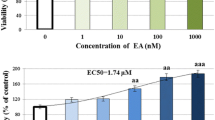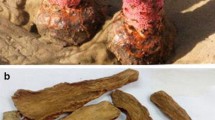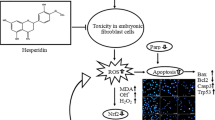Abstract
This study was conducted to define the antioxidant properties and cytoprotective mechanisms of sea buckthorn fruit extract (SFE) against cellular oxidative stress in mouse embryonic fibroblast (MEF) cells. Cell viability of MEF cells damaged by H2O2 was significantly increased by addition of SFE in a concentration dependent manner. Cytoprotective effect of SFE against oxidative damage was observed to be co-related with regulation of cell cycle progression. Induction of cell cycle arrest in G2/ M checkpoint was mediated by oxidative stress, but significantly reduced by treatment of MEF cells with SFE. Analysis of key regulatory proteins involved in G2/M arrest showed that SFE treatment leads to down-regulation of both phosphorylated Chk1 and cyclin B, which play important roles in cell cycle arrest of oxidatively damaged cells. Effect of SFE on apoptosis was evaluated by morphological and flow cytometric analysis. Apoptotic cell accumulation occurred by H2O2 treatment was decreased by co-treatment of MEF cells with SFE. Early apoptotic process involved in DNA fragmentation and condensation was also inhibited by additional treatment with SFE. Overall results suggest that cytoprotective effect of SFE is mediated by effective radical scavenging activity as well as altered cell cycle regulation which prevent apoptotic cell death induced by cellular oxidative stress.
Similar content being viewed by others
References
Rousi A. The genes Hippophae L. a taxonomic study. Ann. Bot. Fenn. 8: 177–227 (1971)
Xu MY, Sun XX, Tong WX. Medical research and development of sea buckthorn. Hippophae 7: 32–40 (1994)
Li TSC, Wang LCH. Physiological components and health effects of Ginseng, Echinacea, and sea buckthorn. Vol. I, pp. 329–356. In: Functional Foods: Biochemical & Processing Aspects. Mazza G (ed). CRC Press, Inc., Boca Raton, FL, USA (1998)
Zeb A. Anticarcinogenic potential of lipids from Hippophae-evidence from the recent literature. Asian Pac. J. Cancer P. 7: 32–35 (2006)
Kruczek M, Swiderski A, Mech-Nowak A, Krol K. Antioxidant capacity of crude extracts containing carotenoids from the berries of various cultivars of sea buckthorn (Hippophae rhamnoides L.). Acta Biochim. Pol. 59: 135–137 (2012)
Guliyev VB, Gul M, Yildirim A. Hippophae rhamnoides L.: Chromatographic methods to determine chemical composition, use in traditional medicine and pharmacological effects. J. Chromatogr. B 812: 291–307 (2004)
Stoner GD, Mukhtar H. Polyphenols as cancer chemopreventive agents. J. Cell. Biochem. Suppl. 22: 169–180 (1995)
McDougall GJ, Ross HA, Ikeji M, Stewart D. Berry extracts exert different antiproliferative effects against cervical and colon cancer cells grown in vitro. J. Agr. Food Chem. 56: 3016–3023 (2008)
Fan J, Ding X, Gu W. Radical-scavenging proanthocyanidins from sea buckthorn seed. Food Chem. 102: 168–177 (2007)
Geetha S, Sai Ram M, Mongia SS, Singh V, Ilavazhagan G, Sawhney RC. Evaluation of antioxidant activity of leaf extract on Seabuckthorn (Hippophae rhamnoides L.) on chromium (VI) induced oxidative stress in albino rats. J. Ethnopharmacol. 87: 247–251 (2003)
Geetha S, Ram MS, Sharma SK, Ilavazhagan G, Banerjee PK, Sawhney RC. Cytoprotective and antioxidant activity of seabuckthorn (Hippophae rhamnoides L.) flavones against tert-butyl hydroperoxideinduced cytotoxicity in lymphocytes. J. Med. Food 12: 151–158 (2009)
Ku HH, Brunk UT, Sohal RS. Relationship between mitochondrial superoxide and hydrogen peroxide production and longevity of mammalian species. Free Radical Bio. Med. 15: 621–627 (1993)
Jauslin ML, Meier T, Smith RA, Murphy MP. Mitochondriatargeted antioxidants protect Friedreich Ataxia fibroblasts from endogenous oxidative stress more effectively than untargeted antioxidants. FASEB J. 17: 1972–1974 (2003)
Dipaola RS. To arrest or not to G2-M cell-cycle arrest. Clin. Cancer Res. 8: 3311–3314 (2002)
Fiorillo C, Oliviero C, Rizzuti G, Nediani C, Pacini A, Nassi P. Oxidative stress and antioxidant defenses in renal patients receiving regular haemodialysis. Clin. Chem. Lab. Med. 36: 149–153 (1998)
Kang YH, Park YK, Lee GD. The nitrite scavenging and electron donating ability of phenolic compounds. Korean J. Food Sci. Technol. 28: 232–239 (1996)
Re R, Pellegrini N, Proteggente A, Pannala A, Yang M, Rice-Evans C. Antoxidant activity applying and improved ABTS radical cation decolorization assay. Free Radical Bio. Med. 26: 1231–1237 (1999)
Heinaaho M, Hagerman A, Julkunen-Tiitto R. Effect of different organic farming methods on the phenolic composition of sea buckthorn berries. J. Agr. Food Chem. 57: 1940–1947 (2009)
Gao X, Ohlander M, Jeppsson N, Björk L, Trajkovski V. Changes in antioxidant effects and their relationship to phytonutrients in fruits of sea buckthorn (Hippophae rhamnoides L.) during maturation. J. Agr. Food Chem. 48: 1485–1490 (2000)
Ozcan E. A novel automated direct measurement method for total antioxidant capacity using a new generation, more stable ABTS radical cation. Clin. Biochem. 37: 277–285 (2004)
Zhou YL, Ruan DJ, Yang BC, Wang SZ. A study on Vc content of Hippophae rhamnoides fruit and its changing rules. Forest Res. 3: 345–349 (1991)
Suleyman H, Gumustekin K, Taysi S, Keles S, Oztasan N, Aktas O, Altinkaynak K, Timur H, Akcay F, Akar S, Dane S, Gul M. Beneficial effects of Hippophae rhamnoides L. on nicotine induced oxidative stress in rat blood compared with vitamin E. Biol. Pharm. Bull. 25: 1133–1136 (2002)
Chua PJ, Yip GW, Bay BH. Cell cycle arrest induced by hydrogen peroxide is associated with modulation of oxidative stress related genes in breast cancer cells. Exp. Biol. Med. 234: 1086–1094 (2009)
Chen QM, Liu J, Merrett JB. Apoptosis or senescence-like growth arrest: influence of cell-cycle position, p53, p21 and bax in H2O2 response of normal human fibroblasts. Biochem. J. 347: 543–551 (2000)
Berselli PV, Zava S, Montorfano G, Corsetto PA, Krzyzanowska J, Olwszek W, Berra B, Rizzo AM. A mint purified extract protects human keratinocytes from short-term, chemically induced oxidative stress. J. Agr. Food Chem. 58: 11428–11434 (2010)
Kaufmann WK, Levedakou EN, Grady HL, Paules RS, Stein GH. Attenuation of G2 checkpoint function precedes human cell immortalization. Cancer Res. 55: 7–11 (1995)
Hiaro A, Cheung A, Duncan G, Girard PM, Elia AJ, Wakeham A, Okada H, Sarkissian T, Wong JA, Sakai T. Chk2 is a tumor suppressor that regulates apoptosis in both an ataxia telangiectasia mutated (ATM)-dependent and an ATM-independent manner. Mol. Cell Biol. 22: 6521–6532 (2002)
Heffernan TP, Kawasumi M, Blasina A, Anderes K, Conney AH, Nghiem P. ATR-Chk1 pathway inhibition promotes apoptosis after UV treatment in primary human keratinocytes: potential basis for the UV protective effects of caffeine. J. Invest. Dermatol. 129: 1805–1815 (2009)
Bijur GN, Briggs B, Hitchcock CL, Williams MV. Ascorbic aciddehydroascorbate induces cell cycle arrest at G2/M DNA damage checkpoint during oxidative stress. Environ. Mol. Mutagen. 33: 144–152 (1999)
Rogakou EP, Nieves-Neira W, Boon C, Pommier Y, Bonner WM. Initiation of DNA fragmentation during apoptosis induces phosphorylation of H2AX histone at serine 139. J. Biol. Chem. 275: 9390–9395 (2000)
Author information
Authors and Affiliations
Corresponding author
Rights and permissions
About this article
Cite this article
Lim, SR., Go, EB., Go, G. et al. Antioxidative mechanisms of sea buckthorn fruit extract in mouse embryonic fibroblast cells. Food Sci Biotechnol 22 (Suppl 1), 197–204 (2013). https://doi.org/10.1007/s10068-013-0067-z
Received:
Revised:
Accepted:
Published:
Issue Date:
DOI: https://doi.org/10.1007/s10068-013-0067-z




